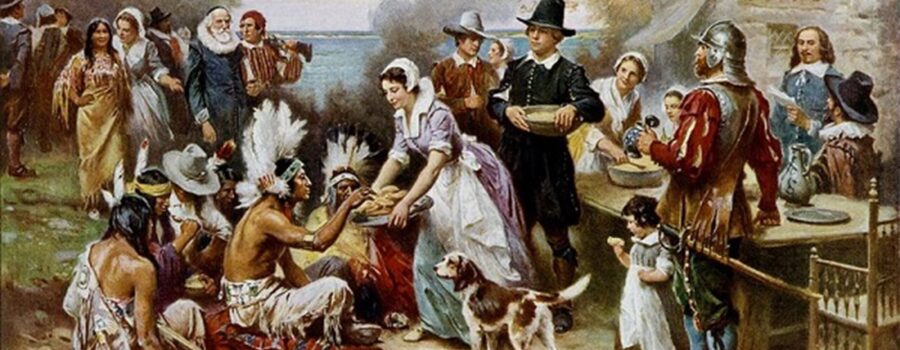The Mayflower set sail on September 16th, 1620 and arrived in Massachusetts on November 11th. It took 66 grueling days at sea to reach North America. The pilgrims set out to escape what they saw as religious persecution by the Anglican Church of England. They were viewed as protestant purists who desired to purify the church, hence the nickname Puritans.
King James I of King James Bible Translation fame was the head of the Anglican Church. He interpreted any criticism of the Anglican church as treason, and authorized fines, imprisonment, and even execution of dissenters. (So much for religious liberty)
Of the 102 who set out only 53 survived the long journey from Plymouth in southern England to Cape Cod Massachusetts and the first winter in the new world. Starvation and disease killed off almost half of the original pilgrims. Later the Mayflower arrived in Plymouth Harbor on December 16th and the colonists began building their town.
Little did they know the hardships they would experience onboard ship would include emergency repairs, disease, death and even the birth of a new child. Elizabeth Hopkins gave birth to her first son whom she aptly named Oceanus. The child’s father was fellow Mayflower passenger Stephen Hopkins. Oceanus died at the age of two as the pilgrims were settling in to their new environment.
Thanksgiving to God
So there was quite a bit to be thankful for after surviving a treacherously dangerous 2,750 mile journey by sea and a very tough first winter in the new world. There is some debate historically as to when the first Thanksgiving took place. Tradition has it that it was November 1621.
The 53 surviving pilgrims made it through that first winter and, with the help of the local Wampanoag tribe, they had a hearty supply of food to sustain them through the next winter.
According to History.com, most of what is known about the first Thanksgiving comes from a letter written by Edward Winslow in December of 1621. Winslow was one of the first 100 people to sail from England and one of the founders of Plymouth Colony. Another account is cited in William Bradford’s journal titled Of Plymouth Plantation. Bradford became the first Governor of Plymouth Colony and served 5 consecutive terms
Here’s how Winslow described the first Thanksgiving feast in a letter to a friend:
“Our harvest being gotten in, our governor sent four men on fowling, that so we might after a special manner rejoice together after we had gathered the fruits of our labor. They four in one day killed as much fowl as, with a little help besides, served the company almost a week.
At which time, amongst other recreations, we exercised our arms, many of the Indians coming amongst us, and among the rest their greatest king Massasoit, with some ninety men, whom for three days we entertained and feasted, and they went out and killed five deer, which we brought to the plantation and bestowed on our governor, and upon the captain and others.
And although it be not always so plentiful as it was at this time with us, yet by the goodness of God, we are so far from want that we often wish you partakers of our plenty.”
Who Was at the First Thanksgiving?
The famous painting The First Thanksgiving 1621 by Jean Leon Gerome Ferris from 1912 is the picture used in this blog. It depicts that first event which is said to have lasted 3 days. According to eyewitness accounts among the pilgrims were 22 men, four women and 25 children and teenagers.
Guests at the feast included about 90 Wampanoag Indians including their leader Massasoit. One of these Indians was a young man named Squanto who spoke fluent English. He was appointed by Massasoit to serve as the pilgrim’s translator and guide. Squanto learned English prior to the pilgrim’s arrival after he was captured by English explorers and spent time in Europe as a slave.
At the first Thanksgiving, colonists were outnumbered by about two to one by their Native American guests. Edward Winslow writes: “many of the Indians coming amongst us, and amongst the rest their greatest king Massasoit, with some ninety men.”
Squanto taught the Pilgrims to fertilize the soil with dried fish remains to produce a stellar corn crop. In exchange for assistance with defense against the feared enemy, the Narragansett tribe, Massasoit supplemented the food supply of the Pilgrims for the first few years.
Likely What They Did Have at the First Thanksgiving
Venison (deer)
Fowl (geese and duck)
Corn, onions & herbs
Nuts (walnuts, chestnuts, beechnuts)
Shellfish
Venison was a major ingredient, as well as fowl, but that likely included geese and ducks. Turkeys were possible from ‘fowling expeditions’. Pilgrims grew onions and herbs. Cranberries and currants would have been growing wild in the area, and watercress may have still been available if the hard frosts had held off, but there’s no record of them having been served. Their meal was probably heavy on the meats.
Likewise, walnuts, chestnuts, and beechnuts were abundant, as were sunchokes. Shellfish were common, as were beans, pumpkins, squashes, and corn (served in the form of bread or porridge), thanks to the Wampanoags.
Definitely What They Did Not Have at the First Thanksgiving
A turkey centerpiece
Potatoes (white or sweet)
Bread stuffing or pie (wheat flour was rare)
Sugary desserts
Aunt Marcie’s green bean casserole
That jellied cranberry sauce from a can
Football
Courvoisier and stogies
Famous descendants
Americans who can trace their lineage back to a passenger on the Mayflower include:
Marilyn Monroe, Bing Crosby, former Presidents John Adams, John Quincy Adams, George H.W. Bush, George W. Bush and James Garfield, Julia Child, Clint Eastwood, astronaut Alan Shepherd, and Topo Gigio.
So the first Thanksgiving took place over 400 years ago.
What are YOU thankful for today…?
Blessed are you Lord God, king of creation who provides us with Life, Liberty, and the Pursuit
of Happiness….Lee




